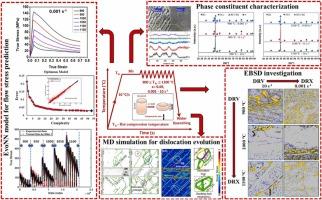cocrfeni HEA热加工变形机理及预测建模
IF 6.3
2区 材料科学
Q2 CHEMISTRY, PHYSICAL
引用次数: 0
摘要
本研究揭示了高熵合金(HEA)热变形行为的新见解,强调了其独特的双相组织和变形机制。该合金具有稳定的微观组织,包括无序BCC和有序B2片片交替的BCC基体和FCC次级相,在所有变形条件下都保持一致,表现出优异的微观组织稳定性。通过分子动力学模拟,发现FCC/BCC界面是导致应变硬化的关键因素。此外,TEM分析提供了有序B2相的亚结构演化的前所未有的细节,包括位错细胞壁、波状滑移和缠结,为HEAs的变形机制提供了新的视角。开发了一种机器学习模型,通过捕获变形参数的复杂非线性依赖关系来准确预测流动应力,提供了一种强大的预测工具。这些发现促进了对HEAs的理解,突出了热机械加工过程中微观结构、相界面和位错动力学之间复杂的相互作用,对设计高性能合金具有重要意义。本文章由计算机程序翻译,如有差异,请以英文原文为准。

Deformation Mechanisms and Predictive Modeling of AlCoCrFeNi HEA under Hot Working Conditions
This study unveils novel insights into the hot deformation behavior of AlCoCrFeNi high-entropy alloy (HEA), emphasizing its unique dual-phase microstructure and deformation mechanisms. The alloy’s stable microstructure, featuring a BCC matrix with alternating disordered BCC and ordered B2 lamellae and an FCC secondary phase, remained consistent across all deformation conditions, showcasing exceptional microstructural stability. A key novelty lies in the identification of FCC/BCC interfaces as critical contributors to strain hardening, revealed through molecular dynamics simulations. Additionally, TEM analysis provided unprecedented details on substructural evolution within the ordered B2 phase, including dislocation cell walls, wavy slip, and entanglements, offering new perspectives on deformation mechanisms in HEAs. A machine learning model was developed to accurately predict flow stress by capturing the complex nonlinear dependencies on deformation parameters, offering a robust predictive tool. These findings advance the understanding of HEAs, highlighting the intricate interplay between microstructure, phase interfaces, and dislocation dynamics under thermomechanical processing, with implications for designing high-performance alloys.
求助全文
通过发布文献求助,成功后即可免费获取论文全文。
去求助
来源期刊

Journal of Alloys and Compounds
工程技术-材料科学:综合
CiteScore
11.10
自引率
14.50%
发文量
5146
审稿时长
67 days
期刊介绍:
The Journal of Alloys and Compounds is intended to serve as an international medium for the publication of work on solid materials comprising compounds as well as alloys. Its great strength lies in the diversity of discipline which it encompasses, drawing together results from materials science, solid-state chemistry and physics.
 求助内容:
求助内容: 应助结果提醒方式:
应助结果提醒方式:


